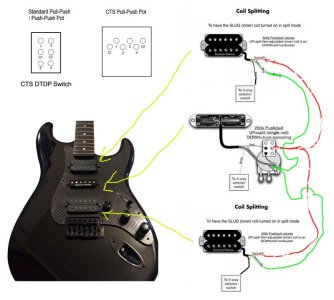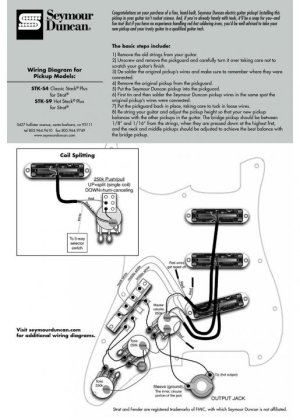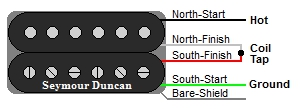Hello,
New here but have been working on my custom HSH Fender Strat for a while now.
The Strat is the one pictured below and uses all Seymour Duncan pickups. The pickup configuration is HSH.
The wiring is just like an oem standard stratocaster including the 5-way switch (Neck P/U, Neck & Center P/U, Center P/U, Center & Bridge P/U, Bridge P/U).
The 2nd Tone knob is a CTS Push-Pull switch.
I want to use the Switch wired for Coil Splitting:
-Down position would be all pickups in noise canceling(Humbucker) mode.
-Up position would be coil splitting or all 3 Pickups as single coil (SSS)
The DTDP CTS switch in a certain position, the vertical connections are not connected to the corresponding opposite side connections (DTDP switch).
The C1 & 2 connections are for the middle Seymour Duncan P/U (Seymour Duncan STK-S4m Stack Plus)
The C2 & 4 connections are for both Hum. Seymour Duncan P/Us (Neck: Seymour Duncan Sentient & Bridge: Seymour Duncan Nazgul).
The 'hot' wires from all P/Us go to the 5-way switch as usual.
Basically wondering if this would work. The bridge and neck Humbuckers (red and white wires for coil splitting) are both connected to #4 on the CTS DTDP switch. These are never used at the same time using the strat 5-way switch.
New here but have been working on my custom HSH Fender Strat for a while now.
The Strat is the one pictured below and uses all Seymour Duncan pickups. The pickup configuration is HSH.
The wiring is just like an oem standard stratocaster including the 5-way switch (Neck P/U, Neck & Center P/U, Center P/U, Center & Bridge P/U, Bridge P/U).
The 2nd Tone knob is a CTS Push-Pull switch.
I want to use the Switch wired for Coil Splitting:
-Down position would be all pickups in noise canceling(Humbucker) mode.
-Up position would be coil splitting or all 3 Pickups as single coil (SSS)
The DTDP CTS switch in a certain position, the vertical connections are not connected to the corresponding opposite side connections (DTDP switch).
The C1 & 2 connections are for the middle Seymour Duncan P/U (Seymour Duncan STK-S4m Stack Plus)
The C2 & 4 connections are for both Hum. Seymour Duncan P/Us (Neck: Seymour Duncan Sentient & Bridge: Seymour Duncan Nazgul).
The 'hot' wires from all P/Us go to the 5-way switch as usual.
Basically wondering if this would work. The bridge and neck Humbuckers (red and white wires for coil splitting) are both connected to #4 on the CTS DTDP switch. These are never used at the same time using the strat 5-way switch.



